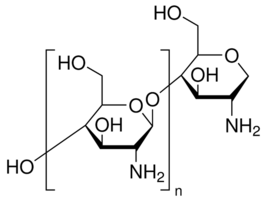“Have you ever watched a crab on the shore crawling backward in search of the Atlantic Ocean, and missing? That’s the way the mind of man operates.” -H. L. Mencken
While crabs might be crawling backward, scientific thinking on chitosan, a crab shell derivative, has been moving full speed ahead. According to pubmed.gov search, the first publications on chitosan appeared in the 1950s. Since 2001, chitosan has become a very popular topic, with 1,800 publications in 2013 alone. We even talked about it recently in the Polymer Solutions Newsletter. (See: Polymers for Dinner?)
What is it that makes it so special?
The polysaccharide chitosan, a random mix of deacetylated (D-glucosamine) and ace tylated (N-acetyl-D-glucosamine) units, is obtained from the shells of crustaceans, such as crab and shrimp. Treating the shells with alkali gives access to its natural polymer. This treatment makes chitosan water-soluble (though mostly at acidic pH*), which, along with its affinity to negative charges and excellent biocompatibility, is the key to its many talents.
tylated (N-acetyl-D-glucosamine) units, is obtained from the shells of crustaceans, such as crab and shrimp. Treating the shells with alkali gives access to its natural polymer. This treatment makes chitosan water-soluble (though mostly at acidic pH*), which, along with its affinity to negative charges and excellent biocompatibility, is the key to its many talents.
Applications of chitosan are amazingly diverse. Its uses have been reviewed in the International Journal of Research in Pharmaceutical and Biomedical Sciences. According to Gavhane Yogeshkumar et al.:
Chitosan has received considerable attention as a possible pharmaceutical excipient in recent decades, due to its good biocompatibility and low toxicity properties in both conventional excipient applications as well as in novel application. Some of the general applications of Chitosan in the pharmaceutical fields include:
Diluents in direct compression of tablets Binders in wet granulation Slow-release of drugs from tablets and granules Drug carriers in micro particle systems Films controlling drug release Preparation of hydrogels, agents for increasing viscosity in solutions Wetting agents, and improvement of dissolution of poorly soluble drug substances Disintegrants Bioadhesive polymers Site-specific drug delivery (e.g. to the stomach or colon) Absorption enhancement (e.g. for nasal or oral drug delivery) Biodegradable polymers (implants, microparticles) Carriers in relation to vaccine delivery or gene therapy
Amazingly, this natural polymer is known to be antibacterial, anti-cancerous, anti-coagulant, antifungal, hemostatic, immunostimulating, wound-healing, anti-inflammatory and anti-viral, and it improves kidney function, on top of all of this. It even has fat-blocking properties!
Commercial applications of chitosan focus on agricultural and horticultural use, water filtration, and biomedical applications, including tissue engineering applications such as skin, bone, cartilage, liver, nerve and blood-vessel scaffolds. Since it is edible, chitosan also is used in crop protection and food preservation. You can find it in the textile and paper industries, as well as in cosmetics. Biotechnological applications of chitosan focus on cell stimulation, wound healing, and surgical adhesion. Nanoparticles and nanofibers of chitosan are obtained in a wide range of shapes and sizes.
There’s only one small drawback: Chitosan might cause and allergic reaction in individuals allergic to shellfish … otherwise, it’s a piece of cake! (crab cake, that is).
* Some chitosan derivatives are water-soluble at neutral pH, which favors medical, cosmetic and food applications.
Source: Pubmed.gov, US National Library of Medicine National Institutes of Health
Source: “Chitosan and Its Applications: A Review of Literature”, by Gavhane Yogeshkumar N., Gurav Atul S., Yadav Adhikrao V., International Journal of Research in Pharmaceutical and Biomedical Sciences, Vol. 4 (1) Jan– Mar 2013, pp.312-331
Image by Charlesjsharp
Chitosan formula by Sigma-Aldrich
